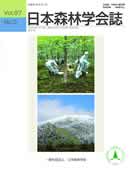All issues

Volume 97 (2015)
- Issue 6 Pages 269-
- Issue 5 Pages 225-
- Issue 4 Pages 169-
- Issue 3 Pages 135-
- Issue 2 Pages 95-
- Issue 1 Pages 1-
Volume 97, Issue 3
Displaying 1-4 of 4 articles from this issue
- |<
- <
- 1
- >
- >|
Articles
-
Akira Tamura, Haruki Orita, Hiroo Yamada, Yoko Fukuda, Keisuke Yano, M ...2015Volume 97Issue 3 Pages 135-142
Published: June 01, 2015
Released on J-STAGE: August 01, 2015
JOURNAL FREE ACCESSA lengthy (4-yr) nursing period is necessary for raising containerized seedlings of the spruce tree Picea jezoensis Carr, and here we sought to devise a method to shorten this long nursing period. We examined 84 treatments and identified the optimum conditions for shortening the nursing period: four environmental conditions, three types of multi-cavity containers, and seven types of growing media. When we raised containerized seedlings using 300-cc multi-cavity containers with 100% coco-peat as the growing medium in a glass greenhouse in which high-pressure sodium lamps were equipped to create 18-h-long-days, the height and root color dia. of 77% of the containerized seedlings were > 20 cm and > 4 mm respectively, which is a tentative 2 nd standard size of containerized Picea glehnii seedlings, and these results were achieved within 2 yrs. We also observed that the promoting growth effects on the seedlings were similar among provenances in the glass greenhouse equipped as described above. This technique thus has the potential to significantly shorten the nursery period of containerized Picea jezoensis seedlings.View full abstractDownload PDF (1104K) -
Yoshiyuki Chinen, Masami Shiba2015Volume 97Issue 3 Pages 143-152
Published: June 01, 2015
Released on J-STAGE: August 01, 2015
JOURNAL FREE ACCESS
Supplementary materialThis paper reviews the historical changes of house building materials in Okinawa related to construction methods and forestry policies. The traditional wooden houses construction in Okinawa had changed its trends to reinforce concrete houses. After the invasion of the Satsuma domain, Ryukyu Kingdom was utilized dual governed system from both Japanese and Chinese rules. This event had caused an economic difficulties and depletion of the forest resources. In the middle of 18th century, a drastic reformation by Sai On affected house construction that fixed societal ranks and the village landscape had changed into a checkerboard pattern. Conventional policies used in Okinawa of the Meiji period, was not managed accordingly and it caused degradation of forest resources that caused Okinawa to import timber from main islands of Japan. After the World War II, the United State Forces occupied Okinawa Island until 1972. Low-priced timber imported from Japan under import promotion policy forced between 1950 and 1958 had led to the promotion of wooden house constructions. The government substitute import materials to cement and plywood production, promote export activities to prevent trade deficit and support the increment of concrete houses. Besides the advancement in wood pre-cutting process, the government recently conducted domestic timber usage promotion that led to competition and market reclamation between timber suppliers and these factors had increased the development of the wooden houses construction over time.View full abstractDownload PDF (1341K)
Review
-
Hayato Masuya, Taisei Kikuchi, Norio Sahashi2015Volume 97Issue 3 Pages 153-157
Published: June 01, 2015
Released on J-STAGE: August 01, 2015
JOURNAL FREE ACCESSTaphrina wiesneri, the causal agent of Witch's broom of Prunus widely damage Prunus trees including Cerasus × yedoensis cv. Somei-Yoshino in Japan. Genome comparisons with three closely related Taphrina species showed that four Taphrina species including T. wiesneri have similar genomes to each other but utilize multiple unique strategies in coping with host environments. Gene duplication and horizontal gene transfer seem to be related to establish the host-parasite interaction such as host specificity and difference of symptoms among the pathogens. Furthermore, several plant hormone (auxin, cytokinin and abscisic acid) -related genes were identified in the genomes. Taphrina wiesneri probably disturbs hormone balances of the host by producing these hormones using these genes and resulted in the specific symptoms such as witch's broom. Genome information provides new insights to expand studies on eco-physiology of T. wiesneri and to develop new gene-targeted fungicides.View full abstractDownload PDF (756K)
Special Issue "Radioactive Contamination to the Forest due to the Fukushima Daiichi Nuclear Power Plant Accident"
Short Communication
-
Yoshiyuki Kiyono, Akio Akama2015Volume 97Issue 3 Pages 158-164
Published: June 01, 2015
Released on J-STAGE: August 01, 2015
JOURNAL FREE ACCESSTo determine the seasonal changes in radioactive cesium (Cs) doses present in the aboveground organs of Petasites japonicus, we collected organ samples each month from March 2013 to October 2013 and from March 2014 to July 2014, and collected litter and surface soil (0-5 cm in depth) in March 2014 in two planted sites, HO and TS plots, in Ibaraki Prefecture. The 137Cs doses of the lamina and leafstalk were high in March when scapes existed and were reduced in May when stand leaf biomass became large. The dose increased again by late summer when biomass decreased in the HO plot, whereas such increase of the dose did not occurred in the TS plot. Neither the air dose rate of radioactivity nor the radioactive Cs deposition in litter and surface soil significantly differed between the two plots. However, the HO plot had overstory trees with approximately three times the total of litter accumulation, accompanied by three times the 137Cs dose, compared with that in the TS plot. The differences in the conditions of overstory trees and litter may explain the seasonal differences in the leaf 137Cs dose between the plots.View full abstractDownload PDF (809K)
- |<
- <
- 1
- >
- >|